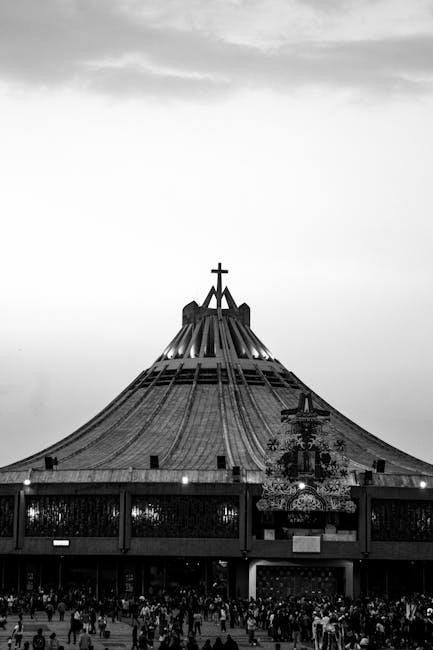The Stations of the Cross are a 14-step Catholic devotion commemorating Jesus Christ’s last day on Earth, focusing on His Passion and death. This spiritual practice includes Scriptural readings, prayers, and reflections, often available in downloadable PDF formats for personal or communal devotion, helping believers deepen their connection to Christ’s sacrifice.
1.1. Definition and Purpose
The Stations of the Cross are a 14-step Catholic devotion that commemorates Jesus Christ’s Passion and death, from His condemnation to burial. Each station represents a specific event in His final journey, inviting believers to reflect on His sacrifice. The purpose is to deepen devotion, foster empathy, and encourage spiritual growth by meditating on Christ’s love and redemption. This practice, often accompanied by prayers and reflections, provides a structured way to connect with the Gospel narrative. The Stations are particularly meaningful during Lent, offering a powerful tool for personal or communal reflection on the significance of Christ’s Passion.
1.2. Historical Background
The Stations of the Cross trace their origins to the early Christian pilgrims who followed the Via Crucis, or Way of the Cross, in Jerusalem. Over time, the devotion evolved, and by the 18th century, it became a standard practice in Catholic churches worldwide. The 14 Stations, representing key events from Jesus’ condemnation to His burial, were formally established. Today, the Stations of the Cross are a cornerstone of Lenten devotion, often accompanied by prayers, reflections, and Scriptural readings. Their enduring popularity reflects the deep spiritual connection Catholics find in meditating on Christ’s Passion and sacrifice.
1.3; Spiritual Significance

The Stations of the Cross hold profound spiritual significance as a devotion that invites believers to reflect deeply on Christ’s Passion and death. By meditating on each station, Catholics cultivate empathy, gratitude, and a deeper understanding of Christ’s sacrifice for humanity. This practice fosters a spirit of repentance, encouraging individuals to seek forgiveness and grow in faith. The Stations also remind believers of the importance of carrying their own crosses with patience and trust in God’s plan. This devotion strengthens spiritual growth, unites the faithful in prayer, and brings solace to those seeking comfort in times of sorrow or hardship.

The 14 Stations of the Cross
The Stations of the Cross are a series of 14 devotional reflections commemorating key events from Jesus’ Passion, from condemnation to burial, fostering spiritual connection.
2.1. Station I: Jesus is Condemned to Death
This station marks the beginning of Jesus’ Passion, where Pontius Pilate condemns Him to death despite finding no guilt. It reflects the injustice and sin of humanity. Devotionally, it invites reflection on the weight of sin and Christ’s obedience to the Father. This moment underscores God’s love and the ultimate sacrifice for redemption.
2.2. Station II: Jesus Takes Up His Cross
At this station, Jesus accepts the cross, symbolizing His obedience and love for humanity. It represents the beginning of His journey to Calvary, where He will sacrifice Himself for the redemption of sin. The cross becomes a powerful symbol of salvation, reminding us of Christ’s willingness to bear the burden of humanity’s sins. This moment invites believers to reflect on their own crosses and how they can embrace their struggles with faith and trust in God’s plan. The image of Jesus carrying the cross encourages prayer and contemplation on the meaning of sacrifice and love.
2.3. Station III: Jesus Falls the First Time
This station depicts Jesus falling under the weight of the cross, a moment of weakness and humanity amidst His divine mission. The fall symbolizes the physical and emotional toll of carrying the burden of sin. It invites reflection on how we, like Jesus, may stumble under life’s challenges. The crowd’s reactions—some jeering, others pitying—mirror how people respond to suffering. Jesus’s perseverance teaches us to rise after falls, trusting in God’s grace. The fallen Jesus reminds us that even in failure, there is hope for redemption and strength to continue our journey. This moment calls for prayer and resilience.
2.4. Station IV: Jesus Meets His Mother
This station captures the deeply emotional encounter between Jesus and His mother, Mary, along the path to Calvary. The meeting underscores the profound sorrow and love they share. Mary, as the Mother of Sorrows, stands as a symbol of faith and strength in the face of suffering. This moment invites reflection on the bond between parent and child and the universal experience of witnessing loved ones endure pain. It also highlights Mary’s unwavering trust in God’s plan, even amidst immense grief. The scene calls for prayers seeking comfort for the sorrowful and grace to bear life’s burdens with faith and love.
2.5. Station V: Simon Helps Jesus Carry the Cross
This station depicts Simon of Cyrene being compelled by Roman soldiers to assist Jesus in carrying the cross. Initially reluctant, Simon’s act becomes a profound moment of service and compassion. It symbolizes the call to share in Christ’s burdens and to embrace humility. The scene reminds us that even in unexpected ways, we are invited to participate in God’s plan. Reflecting on this station, we pray for the grace to willingly support others in their struggles and to carry our own crosses with patience and trust in God’s providence.
2.6; Station VI: Veronica Wipes the Face of Jesus
This station recalls the compassionate act of Veronica, who bravely stepped forward to wipe the face of Jesus as He carried the cross. Her cloth, miraculously imprinted with His image, became a sacred relic. Veronica’s gesture symbolizes selfless love and devotion, reminding us to offer comfort to those suffering. Reflecting on this station, we pray for the courage to show compassion and for the grace to see Christ’s face in those who suffer. May Veronica’s example inspire us to acts of kindness and faith in times of need.
2.7. Station VII: Jesus Falls the Second Time
The second fall of Jesus underscores His human weakness and the immense physical toll of carrying the cross. Despite His exhaustion and pain, Jesus perseveres, demonstrating unwavering determination to fulfill His mission. This station invites us to reflect on our own struggles and weaknesses. Just as Jesus fell but rose again, we are called to persevere through life’s challenges, trusting in God’s grace. The second fall reminds us that even in our frailty, we can find strength in faith and the promise of redemption. Let us pray for the courage to carry our crosses with patience and hope.
2.8. Station VIII: Jesus Meets the Women of Jerusalem
As Jesus carries His cross, He encounters a group of weeping women from Jerusalem. Despite His own immense suffering, Jesus consoles them, saying, “Do not weep for me, but weep for yourselves and for your children;” This moment highlights Jesus’ compassion and foresight, as He mourns the future sorrows of humanity. The women, beating their breasts in lamentation, represent the universal grief over sin and suffering. Jesus’ words call us to reflect on the consequences of sin and the importance of repentance. This station invites us to join in mourning for our own sins while trusting in God’s mercy and redemption.
2.9. Station IX: Jesus Falls the Third Time
Jesus, weakened by physical and emotional torment, falls for the third time under the weight of the cross. This fall symbolizes the immense burden of humanity’s sins, which He willingly bears. It reminds us of our own struggles and failures, inviting us to reflect on how we, like Jesus, must persevere through life’s challenges. The third fall underscores the reality of human frailty but also the triumph of divine love. As we meditate on this station, we are called to embrace our crosses with faith and courage, trusting in God’s grace to strengthen us.
2.10. Station X: Jesus is Stripped of His Garments
At this station, Jesus is stripped of His garments by the soldiers, exposing His vulnerable humanity. This act of humiliation and degradation reflects the depths of human cruelty and the total surrender of Jesus to His Father’s will. The stripping of His clothes symbolizes the stripping away of earthly dignity, reminding us of the cost of redemption. It invites us to reflect on our own attachment to material possessions and status, urging us to embrace humility and detachment. Jesus’s willingness to endure this indignity underscores His unwavering commitment to our salvation.
2.11. Station XI: Jesus is Nailed to the Cross
At this station, Jesus is nailed to the cross, enduring immense physical and emotional pain. The nails driven into His hands and feet symbolize His complete sacrifice for humanity’s sins. This act of crucifixion represents the ultimate act of self-giving love and the fulfillment of Jesus’s mission to redeem humanity. The cross becomes a symbol of salvation, where Jesus’s suffering unites with the struggles of all people. Reflecting on this station invites us to contemplate the depth of Christ’s love and the transformative power of sacrifice, urging us to embrace our own crosses in imitation of His divine example.
2.12. Station XII: Jesus Dies on the Cross
This station marks the culmination of Jesus’s Passion, as He surrenders His life on the cross. His death symbolizes the ultimate sacrifice for the redemption of humanity. As Jesus’s body goes limp, His mission of love and forgiveness is fulfilled. The piercing of His side with a spear confirms His death and signifies the Eucharistic sacrifice. This moment is both deeply sorrowful and profoundly hopeful, as it leads to the resurrection. Reflecting on this station, we are reminded of the immense love Christ has for us and the eternal life His death makes possible, inviting us to embrace His sacrifice with gratitude and faith.
2.13. Station XIII: Jesus is Taken Down from the Cross
This station depicts the moment when Jesus’s lifeless body is carefully removed from the cross by Joseph of Arimathea and Nicodemus. His mother, Mary, and other devout followers mourn the loss of their beloved Messiah. The act of taking Jesus down from the cross symbolizes the end of His physical suffering and the beginning of His journey to the tomb. This station invites reflection on the profound grief of those who loved Him and the deep respect shown in handling His sacred body. It also reminds us of the unwavering love and sacrifice that defined His mission. The sorrow here prepares us for the hope of resurrection.
2.14. Station XIV: Jesus is Buried
The final station portrays the burial of Jesus in a tomb provided by Joseph of Arimathea. With the help of Nicodemus, His body is wrapped in linen and anointed with spices. The tomb, sealed with a stone, signifies the completion of His earthly journey. This station evokes profound reflection on the sacrifice Jesus made for humanity. It also reminds us of the love and respect shown by His followers, even in death. The burial marks the end of His physical suffering but sets the stage for the hope of resurrection, which is celebrated at Easter. This station invites us to contemplate the depth of God’s love.

Prayers and Reflections for Each Station
This section provides prayers and reflections for each station, helping deepen the spiritual experience. They connect followers to Christ’s journey, offering comfort, gratitude, and reflection on faith and redemption.
3.1. Preparatory Prayer
A preparatory prayer sets the tone for the Stations of the Cross, inviting believers to open their hearts and minds. It humbly asks for grace to understand the depth of Christ’s sacrifices and to unite with His sufferings. The prayer seeks guidance to walk in faith, reflecting on the love and redemption offered through the Passion. It reminds us to approach the Stations with reverence, gratitude, and a willingness to grow spiritually. This prayer is a heartfelt request to embrace the journey, finding strength in Christ’s love and mercy, and to seek blessings for the spiritual pilgrimage ahead.
3.2. Reflections and Meditations
Reflecting on each Station of the Cross invites believers to deeply connect with Christ’s journey, fostering empathy and spiritual growth. Meditations focus on the emotional and spiritual dimensions of His Passion, encouraging prayerful contemplation. Participants are urged to reflect on their own lives, seeking forgiveness and renewal. Each Station’s imagery and Scripture inspire personal connection, helping individuals to identify with Christ’s sacrifices and virtues. These reflections guide believers to embrace compassion, humility, and gratitude, drawing closer to God’s love. The meditations also highlight the universal themes of suffering, redemption, and hope, offering solace and strength for daily life.
3.3. Closing Prayer
The Closing Prayer serves as a heartfelt conclusion to the Stations of the Cross, expressing gratitude for the spiritual journey and seeking divine grace. It invites believers to reflect on the lessons learned and to remain mindful of Christ’s love and sacrifice. The prayer often includes petitions for strength, forgiveness, and the grace to live according to His teachings. Many closing prayers also honor the Blessed Virgin Mary, asking for her intercession. This final prayer unites the faithful in a spirit of humility and devotion, sealing the meditation with a commitment to follow Christ more closely in daily life.

The Significance of the Stations of the Cross in Lent
The Stations of the Cross deepen Lenten devotion by fostering reflection on Christ’s Passion, encouraging spiritual growth, and uniting believers in prayer and communal worship.
4.1. Spiritual Preparation for Easter
The Stations of the Cross are a powerful tool for spiritual preparation during Lent, helping believers deepen their reflection on Christ’s journey to Calvary. By meditating on each station, individuals can align their hearts with Christ’s sacrificial love, fostering a deeper understanding of His Passion. This devotion encourages prayer, repentance, and gratitude, preparing the soul for the resurrection’s joy. The Stations bridge the spiritual and emotional connection to Easter, inviting Catholics to walk with Christ and renew their commitment to faith, ensuring a meaningful and transformative Lenten season.
4.2. Commemorating Christ’s Passion
The Stations of the Cross serve as a poignant reminder of Christ’s Passion, inviting believers to reflect on His sacrificial love. By retracing Jesus’ journey to Calvary, the devotion fosters a deeper connection to the events of His suffering and death. Each station represents a specific moment in His Passion, from condemnation to burial, allowing Catholics to contemplate the physical and emotional torment He endured. This practice honoring Christ’s ultimate sacrifice strengthens devotion and gratitude, especially during Lent, as it prepares hearts to embrace the redemption won through His resurrection.
4.3. Community and Devotion

The Stations of the Cross foster a sense of community and shared devotion among Catholics. Often practiced collectively during Lent, this tradition unites believers in reflection and prayer, strengthening bonds of faith. Participating together, whether in a church or through a PDF guide, creates a shared spiritual experience, emphasizing the importance of communal worship. The devotion also encourages mutual support, as individuals pray for one another while meditating on Christ’s sacrifice. This collective act of faith deepens personal and communal connection to the Passion of Christ, fostering a spirit of unity and shared purpose.

Downloading and Using a Stations of the Cross PDF
A Stations of the Cross PDF offers a convenient and accessible way to follow the devotion. It includes prayers, reflections, and visuals, making it easy to meditate on Christ’s Passion. The digital format allows for portability, enabling individuals to pray anywhere. Many PDFs are free, sharable, and adaptable to personal or group use, fostering spiritual engagement and community participation during Lent or anytime.
5.1. Benefits of a PDF Format

The Stations of the Cross PDF offers numerous benefits, including easy accessibility and portability. It allows individuals to carry the devotion digitally, ensuring it is always available for reflection. The PDF format is sharable, making it simple to distribute among friends, family, or parish communities. Additionally, PDFs are often free and readily available online, reducing costs and barriers to participation. The format also preserves the layout and visuals, ensuring a consistent and visually appealing experience. This makes it ideal for personal prayer or group devotions, enhancing the spiritual journey during Lent or any time of the year.
5.2. How to Use the PDF for Personal Devotion
To use the Stations of the Cross PDF for personal devotion, begin by finding a quiet, reflective space. Open the PDF on your device or print it for a traditional experience. Start with a preparatory prayer, then proceed to each station at your own pace. Reflect on the scripture, meditation, and prayer provided for each station, pausing to consider the sacrifice and love of Christ. Take time to meditate on how His journey applies to your life. Conclude with a closing prayer, asking for grace and strength. This format allows for a meaningful and intimate spiritual practice, fostering deeper connection with Christ’s Passion.
5.3. Sharing the PDF with Others
Sharing the Stations of the Cross PDF with others is a thoughtful way to spread devotion and deepen faith. Email the PDF to family, friends, or parish members, especially during Lent. Post it on social media platforms like Facebook or Twitter to reach a broader audience. Use messaging apps like WhatsApp or Telegram to share it with prayer groups. Print copies for those without digital access, such as the elderly or those in nursing homes. Encourage others to use it for personal or communal prayer, fostering a sense of unity and shared spiritual growth; Sharing this resource helps others connect with Christ’s Passion and grow in faith.

Variations and Adaptations of the Stations of the Cross
The Stations of the Cross have diverse adaptations, including scriptural, outdoor, and children’s versions, making them accessible to various audiences and contexts globally.
6.1. Scriptural Stations of the Cross

The Scriptural Stations of the Cross are a devotion rooted in the Gospels, focusing on specific biblical passages that narrate Christ’s Passion. Each station is directly tied to a scriptural account, offering a deeper connection to the events leading to Jesus’ crucifixion. This version emphasizes the liturgical and theological significance of the Passion, making it a popular choice for Lenten reflections. By grounding the stations in Scripture, believers can meditate on the Word of God while contemplating the mysteries of Christ’s sacrifice. This approach fosters a profound understanding of the spiritual journey and its relevance to modern Christian life.
6.2. Stations of the Cross for Children
The Stations of the Cross for children are adapted to help young minds understand and reflect on Christ’s Passion. This version uses simpler language and relatable examples to convey the significance of each station. Visual aids, such as illustrations or child-friendly images, often accompany the text to engage young participants. Prayers and reflections are tailored to address themes like love, sacrifice, and forgiveness, making the devotion accessible and meaningful for children. This adaptation fosters spiritual growth and helps kids develop a deeper understanding of Jesus’ journey and its relevance to their lives. It’s a valuable tool for teaching Catholic traditions to the next generation.
6.3. Outdoor Stations of the Cross
Outdoor Stations of the Cross offer a unique way to reflect on Christ’s Passion in natural or public settings. Typically placed in churchyards, parks, or along walking trails, these stations are often designed to withstand the elements. Each station is usually marked with a durable cross, statue, or plaque depicting the scene. This outdoor devotion encourages community participation and public witness, allowing believers to walk through Christ’s journey in a peaceful, reflective environment. It also serves as a vivid reminder of faith and sacrifice, accessible to all who pass by, fostering meditation and connection with nature while honoring the Lord’s Passion.
The Stations of the Cross are a profound devotion that invites believers to walk with Christ through His Passion and resurrection. By reflecting on each station, individuals deepen their understanding of His sacrifice and the redemption it offers. The availability of a Catholic Stations of the Cross PDF makes this tradition accessible to everyone, fostering personal and communal devotion. Whether prayed in a church, at home, or outdoors, the Stations remain a powerful tool for spiritual growth during Lent and throughout the year, drawing hearts closer to the heart of Christ in love, gratitude, and faith.


